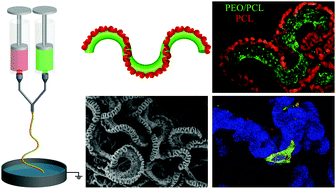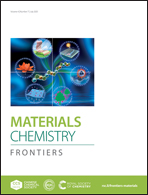A biocompatible artificial tendril with a spontaneous 3D Janus multi-helix-perversion configuration†
Abstract
A helical perversion as a singularity structure is widely seen in nature, such as a climbing plant tendril, which is referred to as a kinked state connecting two helices with opposite chirality. Although previous macroscale elastic bistrip systems have been used to fabricate multiple helix-perversion structures, it is still challenging to obtain multi-perversions on the microscale. Herein, we have for the first time, discovered an interesting phenomenon when PCL microcoils were assembled on PEO/PCL microstems using wet, side-by-side electrospinning which combines side-by-side electrospinning with coagulation bath collection. Such side-by-side electrospun Janus microfibers, due to the mismatch strain between the two jets in the coagulation bath, are transformed into 3D multi-helix-perversion microstructures through self-scrolling. On the 3D multi-helix-perversion microstructures, the growth of HUVECs (human umbilical vein endothelial cells) are observed with a preferential cell distribution of around 86% on the PCL microcoils. Simultaneously, higher focal adhesion, enhanced cell proliferation and elongation are also exhibited by the PCL microcoils, leading to a distinctive 3D Janus cellular pattern. Such novel 3D multi-helix-perversion microstructures have great potential in 3D Janus biomaterials for adjustable cell patterning.



 Please wait while we load your content...
Please wait while we load your content...